The Early Years

Carlton Dehner (right) mingles with employees
It began in Kansas.
The boots that would grow to be known worldwide for their incredible fit and fantastic look had their beginnings in 1875 in the small town of Junction City, Kansas.
It was there, in a small German shoe repair shop, that Carlton C. Dehner first noticed a pair of boots sitting in the back room. Dehner was so taken by the quality and workmanship of the boots he asked, “Why don’t we put in a factory and make these more available?” John Teitzel, the cobbler who owned the small store, was open to the idea and so the Dehner boot line began.
Teitzel was not much of a business man, and at that time Dehner had very little experience working with shoes, but the two formed a perfect partnership. Dehner would handle the business side of the operation, while Teitzel would continue to do what he did best: make boots! Within several weeks the materials and supplies needed to start such a venture began arriving at the store and the first pair of Teitzel & Dehner boots rolled out the doors.

Harold Ketzler
During the early years they were busy supplying custom-made boots for the cavalry officers nearby at Fort Riley. Military demand for quality footwear was high at the time and the Teitzel & Dehner boots were an instant hit.
Business was brisk, and in 1914 Teitzel and Dehner, looking for ways to expand the business, packed up and moved the factory to Wichita, Kansas. It was here that a man by the name of Schuyler Jones joined the team which then became known for a short while as Tietzel, Jones, & Dehner Company. Things soured, however, when Tietzel passed away 1929.
Jones and Dehner did not agree on many issues and during that same year, Carlton Dehner sold his shares in the company to Jones and moved to Omaha. Dehner did not move alone, however, as seven factory employees (half the staff at that time) and his son-in-law Harold Ketzler moved along with him. Dehner first set up shop in a building owned by his brother which was also being used for the creation of artificial limbs. It was here that The Dehner Company, which still is running strong today, was first born.
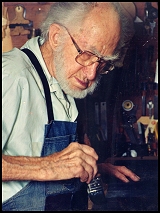
Francis Thompson worked for The Dehner Company for over 70 years
It was also during this time that Donovan (Van) Ketzler, Harold Ketzler’s son and future president of The Dehner Company, first began to work part-time in the factory. Although he was only twelve, he picked up the trade very fast. He was taught to sew and stitch by Francis Thompson, who was one of the original employees to move from Wichita to Omaha, and who remained with the company until his death in the late 1900’s. The first boots were shipped out of Omaha in November of 1930, and for 14 years Dehner and his team remained the building he shared with his brother (1114-16 Farnham Street). As the Dehner name grew expansion was needed yet again and in 1944 Dehner and Ketzler packed up their crew and moved to a new location at 2059 Farnam Street in Omaha. Carlton Dehner passed away not long after and Ketzler took full control of the company.
After Harold Ketzler’s death in 1971, Donovan Ketzler took on the role of president and continued in the footsteps of his father and grandfather before him. It was also during this time that Jeff Ketzler, Donovan’s son and current Dehner president, also began working in the factory.
The Dehner Company remained at their Farnam St. location 38 years before moving to their current facilities at 3614 Martha St. in Omaha. To this day, thousands of boots are crafted every year and shipped out worldwide to eager customers, yearning for the fast-disappearing design and feel of custom-made boots and shoes.
“We have made some changes in the old ways”, Donvan Ketzler said during an interview in 1997. “But the changes were never things that would compromise quality.”
Dehner Today

Bill has been crafting your boots since 1974!
From its beginnings in Junction City Kansas to its current location in Omaha Nebraska, The Dehner Company has been working non-stop to provide the finest quality riding boots, patrol boots, military boots and leather products available. Not only have they succeeded in creating a global following, but The Dehner Company continues to build every boot and shoe by hand, just as was done over a century ago.
The Dehner company is currently headed up by Jeff Ketzler, great-grandson of Carlton Dehner who founded the company in the late 1800’s. Jeff is the third Ketzler to man the helm, preceded by his father Donovan Ketzler and his grandfather Harold Ketzler.
Around the office things have changed a bit. Mary Pat now heads up our accounts and billing department, and Kathy Kovalskas is the friendly voice you will more than likely hear on the other end of the phone. Dustin Champlin heads up the marketing side of things, and although he retired in 1989, you can still find Donovan Ketzler in the office almost every day answering questions and inspecting boots.
Today, Dehner employs a dedicated group of leatherworkers, each of whom has a specific task to complete in the creation of the boot. Many of the Dehner employees have been on the job for years, and they bring all that experience to the table each and every time they craft a pair of boots. In fact, several Dehner leatherworkers were trained by the late Francis Thompson, who was one of the original cobblers to make the move from Kansas to Nebraska in the early 1930’s! “Francis was perhaps one of the most talented and knowledgeable bootmakers of his time” says current president Jeff Ketzler. “There just wasn’t anyone like him.”
Despite rising production costs, The Dehner Company remains steadfast when it comes to boot crafting. Many companies, at the expense of quality, have shifted toward a more cost-effective way of producing footwear (assembly lines, automation, etc). While this may get you your boot faster and for a discounted price, the craftmanship just isn’t there.
For over 130 years the Dehner name has been associated with only the highest quality products, and this won’t be changing any time soon.
We want to hear from you! Submit your old photos or stories about Dehner products to info@dehner.com and see them published here!
Early 80’s Dehner Video
An informative video on how a Dehner boot comes to be from the first cut to the final polish. Originally produced around 1984 and narrated by Dave Webber of Omaha.
Dehner Stories and Reflections
More than just testimonials, these are the Dehner reflections and memories of our loyal customers. This section is always a work in progress so send us your stories today!
My Dehner Boots: Then & Now
 My Dehner Boots: Then & Now
My Dehner Boots: Then & Now
Submitted by CPT Brian Chatham
As a young lieutenant serving in the Cavalry in Europe in the late ’80s, I first became aware of Dehner boots when our new squadron commander took command. He wore a pair of spit-shined tanker boots from day-one. In talking with him, I learned that these boots are a prestigious item for Cavalrymen in the Army. I decided that when my current boots wore-out, I would get me a pair of Dehners.
When I was selected to command a tank company a couple of years later, I immediately wrote to the Dehner Boot Company for a catalog and a ‘kit’ to measure the shape and size of my feet. I selected a pair of 14″ tall Trooper boots. After they arrived from Nebraska, I wore them everyday during my command of the “Charlie Cougars”, 1-66AR, and subsequently, as commander of Headquarters Company.
The Trooper Boots were so well-made and comfortable, that I ordered a pair of 14″ Trooper “Field Boots”. It just didn’t feel right switching from my Dehners to ‘regular’ boots when moving from garrison to the field. I didn’t see them listed on your web site, but they were identical to my “dress” Trooper Boots with the addition of a weatherproofing solution added to the leather to help it stand-up to the harsh conditions in the field. Like my previous pair, they fit like a second skin and were very comfortable. Both pairs of boots were very distinctive and they were often the topic of many questions, comments, and conversations from fellow soldiers who wanted to know more about them.
The photo you see here is of me wearing my Trooper Boots at Fort Hood, standing next to my HMMWV (Hummer). You can clearly see the unit designations on the front fenders (2nd Armored Division, 1st Battalion, 66th Armor, HQ6A). I wish I had a better picture that would better-show your fine product. Sadly, I made the mistake of selling my “dress” Trooper Boots to an eager, young Lieutenant prior to leaving the Army in 1993. However, I still have my field boots and wear them when working ‘tough’ jobs outside and around my house. They are almost 20 years old and they still look and feel great!
Thanks for an amazing product!
The Bootmaker
Van Ketzler: An Officer and a Gentleman

Time To Think: On a snowy day, Van Ketzler rides through the woods near Ponca Hills on his horse Snowdrift. He says these jaunts bring him closer to God.
A story about the life of one of the boot industries most influential people. It was originally written by Robert Nelson and ran in the Omaha World Herald on February 23rd, 1997. Additional pictures have been added. Posted with permission.
Donovan “Van” Ketzler retired as president of the Dehner Boot Co. six years ago, but he still is chairman of the board and he has a small office in the back of the factory.
It’s a sweet deal. His son, Jeff, does all the work as president, but Ketzler can still give a few orders and he can come and go as he likes.
On this day, he wants to go. It’s snowing and very cold. To the old cavalry man, it’s a bully day for horseback riding in the woods.
At about 10 a.m., he springs from his chair, throws on his black wool Army sweater, tan twill riding pants and knee – high Dehner riding boots and charges from his office out through the factory. His stride is long and determined, his chest out, his shoulders back. The rough rider greets his troops on the fly.
“Hello, Mr. Ketzler,” several workers say as they work the leathers. Hello. Hello, Hello, he returns. He marches swiftly around workbenches, past antiquated black sewing machines, and stops abruptly at a thick wood table draped with tanned calf skins from France. He leans and inhales as though smelling a flower. He strokes the soft skin and sighs.
“It’s like touching the hand of a young girl,” he says quietly.
Then he forges on, gives a few more loud hellos and bursts through a door into the front office. “Good – bye,” he says to Dee Sorensen, the office manager, as he heads out the door. “I’m going for a ride.”
She looks out the window into the snowstorm, chuckles and shakes her head:
“There’s no stopping Van.”
For 20 years, Ketzler was the guiding force and forceful personality behind the Dehner Boot Co., which for nearly a century has been one of the world’s premier makers of English riding boots and other footwear. Past customers include Ronald Reagan, Gen. George Patton, Jacqueline Kennedy Onassis and Dwight Eisenhower, to name a few.

Ketzler is everything from Army sergeant to CEO, from aesthete and gentleman to fun-loving partyboy.
The company, which now manufactures more than $2 million worth of boots yearly at its factory at 3614 Martha St., also makes boots for numerous law enforcement agencies. It makes 80 percent of the boots worn by the California Highway Patrol, for example, and supplies the boots worn by the space shuttle astronauts.
Besides enlarging the family – owned business during his 20 – year tenure as president, Ketzler also was instrumental in starting the Omaha Police Department’s horse patrol. He has supported that effort with horses and equipment.
The Greater Omaha Chamber of Commerce gave Ketzler its “Small Business Person of the Year” award in 1995 for his business acumen and community service.
Ketzler became an expert on horses and riding during World War II, when he trained cavalry troopers at Fort Riley in Kansas and later helped Chinese troops fight the Japanese in southwest China. Ketzler retired from active duty as a sergeant, and from reserve duty as a major.
This varied resume has created a unique personality. Depending on the mood and moment, Ketzler is everything from Army sergeant to CEO, from aesthete and gentleman to fun – loving partyboy.
Those who know him well have their “Van stories,” such as the time he drove the Sherman tank down Dodge Street (the Orpheum wanted a tank for the premiere of a World War II movie).
They also know of his idiosyncrasies, such as his daily predawn swim in the nude.
“He has absolutely no shame or modesty,” his son, Jeff, says with a hint of pride.
Another quirk: Ketzler has a driving desire to prepare for every contingency. Just look in the back seat of his extended – cab pickup truck. It’s like a mobile quartermaster shop.
“You could be out somewhere and be eating something and say: ‘Oh, this would be good with dill powder,” Jeff says. “Sure enough, he’ll say ‘I’ve got that’ and he’ll reach in his truck and find some.”
While driving out to his stable just north of Neale Woods, Ketzler reaches back into the pile of items on the back bench. He digs, feels, then pulls out a pair of leather chaps and tosses them on the passenger seat.
“I knew they were in there somewhere,” he says.
Once at the stable, he prepares his horse, Snowdrift, for the ride. He checks each strap twice, then hops on and heads out into the snow and down through trees toward the Missouri River.
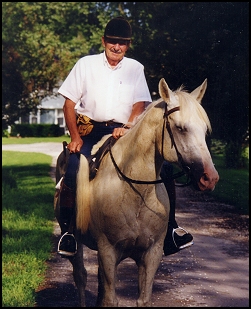
Snowdrift
He is serenely reverent in the cathedral of the snowy forest. This is the quiet Van – the gentleman, the aficionado of quality, the horse lover. The man who “thinks a good long time before he speaks,” according to one friend.
“I love to come here and just think,” he says. “You feel so close to God here.”
Up the trail a bit, Ketzler’s other side peeks through. He talks about the thrill of a fox hunt – Ketzler is the past master of the North Hills Hunt, one of two fox – hunting clubs in the Omaha area. He loves crashing down hillsides, through trees, over fences. It’s the joy of controlled chaos.
He also likes to tell jokes and war stories.
He talks about World War II, about the time he taught marksmanship skills to boxing legend Joe Louis.
“Joe Louis could catch the shell casings ejecting from his .45,” Ketzler says. “He’d shoot and then ZING – he’d reach around behind his back and catch the damn thing! Most people can’t see the casing kicking out and there he was catching ’em seven out of seven times!”
Then his responsible sergeant side returns.
“I guess I should have stopped him, since he was hot – shotting. But the men enjoyed it. Anything like that is good for morale.”
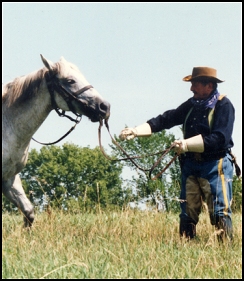
A Military Man
Ketzler’s involvement with horses and the military began when he was 12, the same year he started working in his father’s boot factory. When he wasn’t in school, he was making boots or riding horses with his sister, Janne, at Fort Omaha or the 113th Cavalry stables in Council Bluffs. His father made boots for the officers at both locations, so they let the Ketzler children ride on the weekends. Soon Ketzler and his sister began riding the cavalry troopers’ horses in the youth – age categories in horse – jumping shows around the region.
He met Bette, his wife of 49 years, during this time. She was one of Janne’s close friends. One day, Ketzler took Bette on a ride along the Missouri River bluffs. He headed down a steep slope. Bette’s horse followed.
“It scared the daylights out of her,” he says. “I think that’s why she doesn’t ride to this day.”
He enlisted in the Army after high school, in 1943. He trained in a cavalry unit at Fort Riley. Soon he was an instructor. The Army no longer used mounted cavalry units, but they wanted men to have the discipline of a cavalry – trained soldier.
Ketzler then was sent to China to advise Chinese ground forces. He spent two years there and grew to admire the culture.
Throughout the war years, he also came to appreciate efficiency, precision and preparedness. Many of Ketzler’s friends say he is the most meticulous person they know.
“He can spot the tiniest things wrong with something,” says Vicki Krecek, one of Ketzler’s riding partners. “I think he gets a big kick out of making things right.
“And he’s always the guy with all the maps, with all the routes planned out.”
Ketzler wears a compass on his wrist, and he has a compass in his truck.
When his children were young, he made them practice setting up campsites before family trips. He would load up his three boys and daughter with all the gear, drive around the block, stop and then time how quickly they could set up camp. If they were too slow, they would do it again.
“They still tease me about that,” Ketzler says.
He pushed efficiency at Dehner, too. There, increased efficiency has been within the context of meticulous attention to detail. It is as efficient as fine craftsmanship can be, he says.
“We have made some changes in the old ways,” he says. “But the changes were never things that would compromise the quality. We never just cranked things out.”
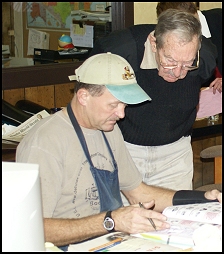
Attention to detail is the cornerstone of Mr. Ketzlers philosophy.
Ketzler returned from the war and went to the University of Nebraska – Lincoln. But he says he couldn’t handle being treated “like a child” after three years in the army. His grandfather was ailing, and his father needed help with the business. So Ketzler quit and came back to Omaha.
“Maybe that’s what I regret most – not having an education,” he says. “I could have learned to communicate better.”
Carlton Dehner and a business associate started the Dehner Boot Co. near Fort Riley around the turn of the century. The company moved to Wichita in 1914. Then Dehner split with his partner and moved the company to Omaha in 1930.
Carlton ran the company with his son – in – law, Harold Ketzler, who was Van’s father. Harold Ketzler’s management style was bit different from his son’s.
“He was much quieter, much more mellow, much more conservative,” Ketzler says. “He was a very nice man, a very good man. I’m a little bit more forceful.
Van took over the business in 1971 when his father died. When he began as president, the factory was making about 15 pair of boots a day, about 3500 boots a year. By the time Ketzler handed the company over to Jeff, Dehner had a new, larger factory and about 700 dealers worldwide, and was making about 9,000 boots a year.
Today the Dehner factory employs 25 people who make 25 to 30 boots daily.
Beyond the finely-tuned skills of the factory’s craftsmen, the Dehner process is fairly simple. They get meticulous foot and calf measurements, then build a tough boot out of the best materials. Want a pair of Dehners? You will pay between $500 and $750 for their English riding boots.
Like his father and grandfather, Ketzler always envisioned his children taking over the business once he retired. All the Ketzler children began working in the factory before they were teenagers. Jeff started folding boxes when he was 8.
When Jeff was 17, Ketzler sent him to Ireland to build a new Dehner factory there. Then Jon, 19 at the time, went to manage it.
“I did push them,” Ketzler says. “Good or bad, I pushed them. They grew up fast.”
Still not fast enough. Jeff admits he was the “wildest of the bunch.” That often put him at odds with his strong-willed father.
It was always a military structure in the house,” Jeff says. “At the time, I didn’t like it much at all.”
Jeff moved out when he was 17.
But looking back now, I’m thankful that he was tough,” Jeff says, “It made me better.”
Now they get along well. They understand each other. And for the most part, Ketzler has allowed Jeff to run the show.
“He is perfectly willing to listen to your point of view as long as you end up doing it his way,” Jeff says, smiling. “But really he has backed off a lot.”
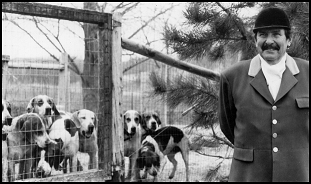
Ketzler with his hounds in 1983
After riding, Ketzler drives back to the factory for a short afternoon of work. He marches back through the factory, through the sweet, heavy smell of tanned skins, through the din of factory sounds – hammers pounding on leather, sewing machines pulsing. More hellos to the workers. He goes to his office in the back. One wall is papered with a large wilderness scene. “That’s my view,” he says. “The sun’s always shining.” Against another wall is an ornate antique liquor cabinet stuffed with files and other papers. The once – elegant cabinet is banged up and covered with thick white paint.
“My mother painted it – she painted everything,” Ketzler says. “She would take a real lovely piece of furniture and paint it. She had a flair for making things grandiose. She was quite a gal.”
Also on the wall: An autographed photo and thank – you letter from Ronald Reagan.
The quality of the Dehner name has lured numerous celebrities. Buying Dehner boots is an intimate affair, so Ketzler has come into close contact with some of the world’s most powerful people.
He remembers the first time Reagan came for some boots. He was still an actor, in town for a movie premiere.
“It’s when he made that Bonzo thing,” Ketzler says. “It was such a flop!”

Donovan Ketzler with son Jeff in the early 80’s
Reagan showed up at the company’s office, ordered a pair of boots and proceeded to become a lifelong fan and advocate of Dehner products.
In the early 1980s, Ketzler was watching a Barbara Walters special in which she went to Reagan’s ranch. Reagan was wearing some old Dehner riding boots.
“The boots were dilapidated, so we sent him some new ones,” Ketzler says.
Semiretirement has given Ketzler the opportunity to travel. He and Bette often take military flights out of Offutt Air Force Base when space is available. They once left for England with three hours notice.
“How many husbands call at 11 a.m. and say we’re going to Europe at 2 p.m.?” Bette says. “You never know what’s going to happen next with him. He keeps life fun.”
That’s why they live in a condominium. It makes for a hasty getaway.
“We can pack up and be on the road quick as can be,” he said. “I like to be able to go when I get the urge.”
Jeff remembers the time his father called from Turkey. “What are you doing in Turkey?” Jeff asked him. “I had never been here,” his father returned.
And Jeff remembers the time Van joined him on a German vacation. From the time Van arrived, he insisted on driving. The two often were on the road 12 hours a day. Jeff never drove.
“He loves to drive and he loves to be the driver,” Jeff says. “That’s just his nature.”
Boots In Space
Dehner Travels Out of this World
So you think you have put a lot of miles on your Dehner boots?

Did Commander Alan B. Shepard wear Dehner boots during the first manned space flight? Photos seem to confirm this.
The Dehner Company prides itself on the durability and life of their boots, but did you know that Dehner boots have been used on space flights and in astronaut training since the early sixties?
In June 1959, B.F. Goodrich ordered eight pairs of Dehner boots at around $41.00 a pair, and another order followed in March of 1960. B.F. Goodrich, along with The David Clark Company, were heading up the production of space suits for “Project Mercury”, which was the United States’ first human space flight program.
At first it was unknown why exactly the boots were being ordered, but after H.K. Siewers, a research specialist for Strategic Air Command (SAC), checked with his sources at Project Mercury it was determined that the boots were in fact ordered for the astronauts. But were these boots ordered for casual wear or was the Dehner name forever going to be attatched to the first manned space flight?
Although to this day no official word has ever been given as to which boot was worn during those first flights in space, many of the photos (such as the one to the right) seem to point towards Dehner. However, other companies did make boots for the Mercury Project which means without official confirmation it may never be known for sure.
In June 1959, B.F. Goodrich ordered eight pairs of Dehner boots at around $41.00 a pair, and another order followed in March of 1960. B.F. Goodrich, along with The David Clark Company, were heading up the production of space suits for “Project Mercury”, which was the United States’ first human space flight program.
At first it was unknown why exactly the boots were being ordered, but after H.K. Siewers, a research specialist for Strategic Air Command (SAC), checked with his sources at Project Mercury it was determined that the boots were in fact ordered for the astronauts. But were these boots ordered for casual wear or was the Dehner name forever going to be attatched to the first manned space flight?

The first boots designed for U.S. astronauts
Although to this day no official word has ever been given as to which boot was worn during those first flights in space, many of the photos (such as the one to the right) seem to point towards Dehner. However, other companies did make boots for the Mercury Project which means without official confirmation it may never be known for sure.

















